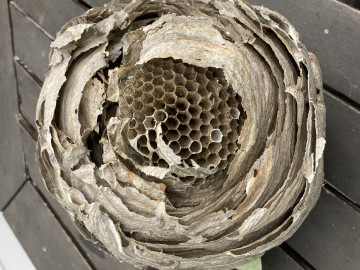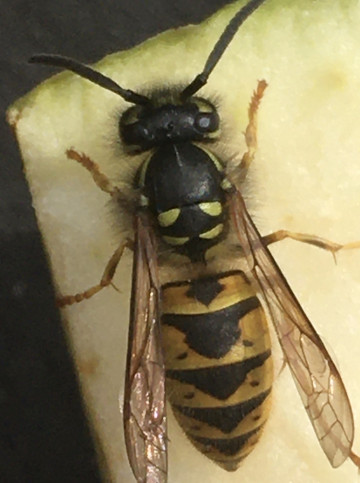![]() This page is regularly updated, please select here to view the latest version.
This page is regularly updated, please select here to view the latest version.
September 2022 Wasp Nest
Well, I know that I promised something more upbeat this month and many of you may feel that this is anything but! However, I couldn’t pass up the opportunity of this fabulous find in a garden only a couple of hundred yards from the Rec. This intricately crafted nest is the work of the common wasp, Vespa Vulgaris, the scourge of many a picnic and BBQ
 But these creatures provide an essential pest control service as well as being useful pollinators. If it wasn’t for them, we would be overwhelmed with caterpillars, greenfly etc and many vegetable crops would suffer. These, and other social wasps, are thought to consume 14 million kilogrammes of such bugs every summer here in the UK. Unlike bees, wasp larvae are carnivorous and feed on other insects brought to them by the worker wasps. However, wasps do resemble bees in having social species that create large communal colonies, and solitary species that create individual nests. There are over 7000 species of wasps in the UK, but only 8 of these are social, and these are the ones that we’re most familiar with, and which we just love to hate.
But these creatures provide an essential pest control service as well as being useful pollinators. If it wasn’t for them, we would be overwhelmed with caterpillars, greenfly etc and many vegetable crops would suffer. These, and other social wasps, are thought to consume 14 million kilogrammes of such bugs every summer here in the UK. Unlike bees, wasp larvae are carnivorous and feed on other insects brought to them by the worker wasps. However, wasps do resemble bees in having social species that create large communal colonies, and solitary species that create individual nests. There are over 7000 species of wasps in the UK, but only 8 of these are social, and these are the ones that we’re most familiar with, and which we just love to hate.
Yet it’s these industrious creatures that are responsible for such incredible creations. The nests are usually built either underground, in abandoned burrows, or anywhere they can find that is dry, safe and able to support the weight of the structure. The nest pictured here was attached to the branch of a viburnum tree about 10’ off the ground. They are built of wood pulp created by mixing scrapings of wood from fences, trees etc with the wasp’s saliva. It is effectively a papier-mâché construction of a number of horizontal layers of downward facing, cells, surrounded by a paper envelope. There is only a single opening at the base of the nest.
nests are usually built either underground, in abandoned burrows, or anywhere they can find that is dry, safe and able to support the weight of the structure. The nest pictured here was attached to the branch of a viburnum tree about 10’ off the ground. They are built of wood pulp created by mixing scrapings of wood from fences, trees etc with the wasp’s saliva. It is effectively a papier-mâché construction of a number of horizontal layers of downward facing, cells, surrounded by a paper envelope. There is only a single opening at the base of the nest.
 Each cell is a perfect hexagon, which allows for optimal strength and use of space. Eggs are laid in the cells and the larvae when fully grown, spin a cap and lining to seal themselves in and pupate. Early in the season, the adults that emerge are female workers whose role is to gather prey for the growing number of larvae and wood pulp to extend the nest. Later in the year more males and new queens are produced. Once this brood of queens has mated they seek out a suitable place to hibernate over the winter. The rest of the colony will eventually die and the nest will disintegrate.
Each cell is a perfect hexagon, which allows for optimal strength and use of space. Eggs are laid in the cells and the larvae when fully grown, spin a cap and lining to seal themselves in and pupate. Early in the season, the adults that emerge are female workers whose role is to gather prey for the growing number of larvae and wood pulp to extend the nest. Later in the year more males and new queens are produced. Once this brood of queens has mated they seek out a suitable place to hibernate over the winter. The rest of the colony will eventually die and the nest will disintegrate.
So what of the wasps that plague us at the end of every summer. Unlike their larvae, adult wasps feed on carbohydrates, mainly sugars. Some of this they obtain from nectar, and some as a sugar rich droplet from the larvae as they feed them. When larvae are no longer being produced, the remaining workers look elsewhere to supplement their sugar fix. They can be seen feeding on rotting fruit and are very partial to the jam on your scone or the sweet, fizzy drink you were just about to enjoy!

Yes, they can be annoying, and they will sting if they feel threatened. But unless you are
seriously allergic to their sting please try to tolerate and respect these much- misunderstood insects. After all, anything that can produce something so beautiful and ephemeral, can’t be all bad!
Words and pictures by Denise Long
![]()


